(en bas de page se trouve un résumé en français)
[ last update: 12.09.2007 ]
The (new) Cadillac Database©
The Cadillac V16
Series 452-452A
1930-1931
Part 3(c)
Fleetwood "43..." Styling Codes
Return to The (New)
Cadillac Database© Index Page
or to the "V-16" index page
![]()
(en bas de page se trouve un résumé en français)
The "Cheap" Sixteens
In this page are illustrated, by means of line drawings1, the various Fleetwood bodies with styling codes beginning "43...". These were what you might call the "bread and butter line", i.e. the cheapest of the vee-sixteen offerings. Taking that comparisons one step further, the V16s in this group may be likened to the popular Series 62 Cadillacs of the fifties and sixties; they were the cheapest models in the range, despite the fact that the cheapest one still cost as much as twenty smaller, popular brands of the time.
With a couple of exceptions that you will easily pick out below, the sixteens in this series have typical body styling characteristics that I have tried to highlight in the artist's view below and that you can see more clearly in the photo below it. These are: (1) a straight lower body sill, (2) a raised, curved molding and bead across the hood, from the radiator down and around the sidemount to meet the body sill ahead of the front door, (3) in general, vertical windshields with stubby "A" pillars.
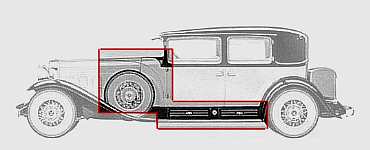
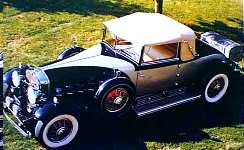
Bird's eye views of the curved bead molding
that distinguishes cars in this grouping
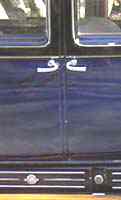
Here, listed in ascending order of rarity, are Fleetwood's
"bread & butter" models on the V-16 chassis
Style 4375S [501 units]: The largest run of a single V16 model was this family sedan. One in more than six V16s sold was this car, costing $6,225. Only 47 equivalent Madame X models sold in the same period, for $7,225 each.
Easy ID: straight sill, large ¼-windows, curved and raised panel on hood;
on the outside, styles 4375 and 4375S look the same;
you need to look inside to spot the differences; the
sedan has no partition nor a division glass
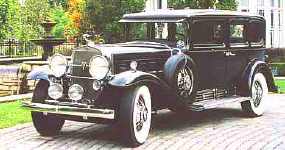
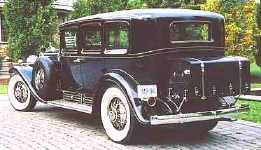
Style 4375 [438 units]: The second most popular selling V16 body style (outsold only by the sedan without glass division) this spacious, family limousine, designed to be chauffeur-driven, cost $6525. That is again $1,000 less than the Madame X equivalent in the "41" series. Article in SIA, No 106, p.33; rear view in SSA 1974, p.26.
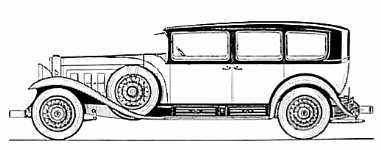
Easy ID: straight sill, large ¼-windows, curved and raised panel on hood;
on the outside, styles 4375 and 4375S look the same;
you need to look inside to spot the differences; the
sedan has no partition nor a division glass
Style 4330S [394 units]: Essentially, this has again the same interior layout as style 4130S. Again it cost $1,000 less than the corresponding Madame X model with the raked windshield. This one cost $5,950.
Easy ID: straight sill, small ¼-windows, curved and raised panel on hood;
On the outside, styles 4330 and 4330S look the same;
you need to look inside to spot the differences; the
sedan has no partition nor a division glass
Style 4361S [258 units]: The Madame X version of this popular body style cost $1,000 more, which may explain why only 43 of the latter found buyers. This one was priced at $5,950.
Easy ID: straight sill, short body, separate trunk, no ¼-windows, curved and raised
panel on hood; On the outside, styles 4361 and 4361S look the same;
you need to look inside to spot the differences; the
sedan has no partition nor a division glass
Style 4380 [250 units]: This was the best selling convertible style in the V16 range, owing to its large occupant capacity and good weather protection when the top was in place. It cost $6,650.
Easy ID: straight sill, curved and raised panel on hood, special belt molding
dipped in rear to accommodate the folding top; this model was available with or without
division glass (this was a mere option; there was no change in the styling number)
Style 4302 [105 units]: a 2-passenger roadster with rumble seat and golf-bag doors, special windshield. Despite a style number starting with digits "43", this car carries a plain hood [no curved, raised panel] and has a straight belt molding; a later coupe body with similar lines was given special a styling code starting with "44". The Fleetwood roadster style "4302" was the cheapest of all the V16s; it cost $5350. Story and photos in SSA 1973, pp.18-21.
The most commonly seen V16 body style is this style#4302 roadster; this car is an exception to the
Fleetwood system of body style coding; it does not feature the usual curved and raised hood panel of Fleetwood
styles with initial digits "43..."; the horizontal belt molding and straight sill should place it with the Madame X
cars but Fleetwood excluded open cars and 2-door models from the Madame X group
Style 4335 [100 units]: A car similar in appearance to roadster style 4235, but again costing $1,000 less in this configuration ($5,900 instead of $6,900).
Easy ID: convertible coupe, straight sill, curved and raised panel on hood
Style 4376 [98 units]: Sales of this popular 2-passenger coupe, costing $5,800, topped by some 20% the sales of the more expensive style 4276 (70 units).
Easy ID: hard-top coupe, straight sill, curved and raised panel on hood
Style 4381 [98 units]: This 5-passenger coupe by Fleetwood,on the V16 chassis, cost $5950. It was a popular late-year addition. In the writer’s collection is an artist's impression of what this body style would have looked like if mounted on the Fleetwood Series "42", chassis with curved, mail-coach sill. Very pretty! Article in SIA106, p.33.
This car too is an exception to the Fleetwood system of body style coding; it does not feature
the usual curved and raised hood panel of Fleetwood styles with initial digits "43...";
the horizontal belt molding and straight sill should place it with the Madame X
cars but Fleetwood excluded open cars and 2-door models from the Madame X group.
Nonetheless, because of its slender windshield posts and chrome window surrounds
this model has a strong Madame X flair about it.
Style 4355S [81 units]: Once again, a cheaper version of style 4155S, with no division glass.
Easy ID: straight sill, no ¼-windows, curved and raisedpanel on hood; on the outside,
styles 4355 and 4355S look the same; you need to look inside to spot the differences;
the sedan has no partition nor a division glass
Style 4355 [52 units]: This is the $1,000 cheaper version of style 4155. It cost $6,350.
Easy ID: straight sill, no ¼-windows, curved and raisedpanel on hood; on the outside, styles
4355 and 4355S look the same; you need to look inside to spot the differences;
the sedan has no partition nor a division glass
Style 4330 [50 units]: Essentially, this car has the same interior layout as style 4130. Again it was cheaper, at $6,300 instead of $7,300.
Easy ID: straight sill, small ¼-windows, curved and raised panel on hood;
on the outside, styles 4330 and 4330S look the same;
you need to look inside to spot the differences; the
sedan has no partition nor a division glass
Style 4325 [35 units]: Essentially, this has the same interior layout as style 4325. The price differential was again the same as for the previous model.
Easy ID: straight sill, long body. no ¼-windows, curved and raised panel on hood
Style 4391 [30 units]: This is a town car with large quarter windows, like style 4291. This one cost $7,150 compared to $8,750 for the latter style with the coach sill. Article in SSA 1990, p.26.
Easy ID: straight sill, long body. large ¼-windows, curved and raised panel on hood
Style 4320 [25 units]: Essentially, this has the same interior layout as style 4320. Again it was cheaper, at $7,150 instead of $8,750.
Easy ID: straight sill, long body. small ¼-windows, curved and raised panel on hood
Style 4312 [24 units]: Essentially, this has the same interior layout as style 4212. It was cheaper, at $7,000 instead of $8,750.
Easy ID: straight sill, shorter body. no ¼-windows, curved and raised panel on hood
Style 4325C [3 units - of which at least one was shipped to Germany] a special town car with folding top over the rear seating area. This car is illustrated in the German "Motor" for June, 1930; it has German license tags # 1A75825.
Easy ID: straight sill, long body. no ¼-windows, curved and raised
panel on hood, opening roof portion over rear seat passengers
Style 4361 [2 units]: a 5-passenger sedan, very similar in interior layout to style 4161 described above. Adding a glass division probably cost in the region of $200 at that time. Article in SIA106, p.34.
Easy ID: straight sill, short body, separate trunk, no ¼-windows, curved and raised
panel on hood; on the outside, styles 4361 and 4361S look the same;
you need to look inside to spot the differences; the
sedan has no partition nor a division glass
Style 4375C [2 units]: Two discriminating buyers chose to have their limousine with the optional landaulet roof, at an additional cost of $800.
Easy ID: straight sill, large ¼-windows, curved and raised panel on hood,
folding roof portion over rear seat passengers; on the outside, styles 4375, 4375S
and 4375C look the same; you need to look inside to spot the differences; the
sedan has no partition nor a division glass; this car had both
Style 4355C [unique]: The Landaulet option was a popular option in the twenties and thirties; this car is a cheaper version of style 4155. No price indication but it may be deduced by adding the cost of the landaulet conversion ($750) to that of the basic model.
Easy ID: straight sill, no ¼-windows, curved and raised
panel on hood, folding roof portion over rear seat passengers; on the outside,
styles 4355, 4355S and 4355C all look the same;
you need to look inside to spot the differences; the
sedan has no partition nor a division glass; this car had both
Photos of the majority of these models may be viewed in the page devoted to
Cadillac V16 production for 1931, as also in the list of survivors_________________________________
1 Included in the product catalog for the Vee-sixteen models is an envelope of designer's drawings of the most common body styles offered; drawings are not available for all styles so, where there was none, I have used an existing drawing and made appropriate changes to illustrate the missing style; sometimes I have had to use my imagination so please do not consider these "montages" as "factory original" drawings.
|
Return to The (New)
Cadillac Database© Index Page
or go back to the V16 index page
© 1996, Yann
Saunders and the Cadillac-LaSalle Club, Inc.
[ Background image: V16 front clip badge, mounted on a stanchion between the headlights ]